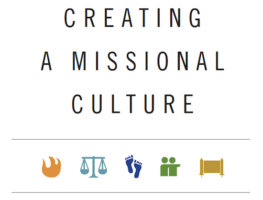 Much has been made about flat leadership in the missional church. Flat leadership of course refers to non-hierarchical forms of church leadership structure. In my experiences, there are various reactions to it. Some assume flat leadership is a reaction to abusive authoritarian structures of leadership. Still others complain that flat leadership means no leadership. Some like it because, in the midst of conflict or confusion in the local church, flat leadership means we talk more or tolerate each other more. For me, all of this misses the point of flat leadership.
Much has been made about flat leadership in the missional church. Flat leadership of course refers to non-hierarchical forms of church leadership structure. In my experiences, there are various reactions to it. Some assume flat leadership is a reaction to abusive authoritarian structures of leadership. Still others complain that flat leadership means no leadership. Some like it because, in the midst of conflict or confusion in the local church, flat leadership means we talk more or tolerate each other more. For me, all of this misses the point of flat leadership.
Three Reasons Flat Leadership Works For Missionary Communities
For me three things drive my attachment to flat leadership structures in the church. First, flat leadership pushes the church outward as opposed to a top-down leadership structure, which draws the church inward. As I have said elsewhere, with top down leadership, the activity of the church flows inward towards the leaders who give direction. They are the professionals. When a member of the body has an issue, concern, or a call to pursue in the field of mission, he or she is trained to first look inward to the leader to answer questions like: How does this fit with our goals and visions? How can we secure resources from the church organization? How can we secure its blessing? Each member of body is passivized as he or she looks inward and upward for approval for what they are doing. The church becomes uniform as it becomes organized around a personality that people like, trust or are drawn to. There are usually a set of issues that distinguish this leader and his/her church from other leaders and their churches. People stay or leave as they are aligned with this person and the positions. In essence each church becomes a “brand” centered around its leadership. This is what top down leadership does. Flat leadership does the opposite. It decenters the life of the church from around a central leader. It pushes people outward. Flat leadership enables the church’s identity to take shape around missional activity in the surrounding culture.
Second, flat leadership structures are more dynamic flexible and discerning of new things. Conflict is important in a church. Differences, disputable matters and the discerning of sin in the body are all important “life matters” that shape a community into the mission we are called. With top down leadership, conflict usually gets litigated through the leadership as opposed to discerned by and among the community. There is very little room to move into new territory unless discerned by the said leader. But, unfortunately, the leader is often engulfed in “managing” the church’s growth now. Conflict is discerned based on what harms or does not harm the cohesiveness and growth of the church body. This stagnates a community quickly. Decentralized flat leadership works against that.
Third, flat leadership models the disposition of Christ we need for mission in the world. With top down leadership, there is often a coercive element here. The leader is often acting out of the authority of the office, in which he or she exercises an authority of position. He or she is set above the congregation instead of below it, as the Scripture seems to dictate for all leadership in the church. Mark 10:42-45. Such leadership does not model the submission to Christ that following Christ demands. It does not model the vulnerability and submission to the Father that Christ Himself modeled and the epistles call all leaders into (Phil 2, 1 Pet 5. 1-6).
For these various reasons, top down leadership works against the body of Christ being incarnational, discerning new territories, entering the world humbly and in the disposition of servanthood. It passivizes the body of Christ from being an alive ministering community of the Spirit extending His Lordship into the world.
The Three P.’s of Leading a Missional Community
Having said all of this however, people still can’t see how such a flat leadership works in the church. We are so driven by a modern Christendom form of leadership which is more efficient and based in a set of cognitive skills sufficient in Christendom, but woefully inadequate for the missionary situation we find ourselves in. So, recently, I was asked, about two months ago, while we were in the midst of a conflict in our body, to describe for our shepherd board the principles of how our leadership works. I wrote three things on a napkin that I have since used over and over again. I now call them “the three P.’s.” They are
1.) Posture. All leadership is called to model the POSTURE of submission to Christ as Lord of the church and (in that) the posture of mutual submission to one another in all activities of leadership. This posture, which Yoder called “revolutionary subordination,” is the place out of which God works to reveal the truth. In dialogue with one another, in listening, and in pushing each other, a consensus is birthed. And until that time we wait and listen more.
2.) Process. The process of Matt 18:15-20 is fundamental to how we navigate issues in the church. The issues the church must deal with arise from on the ground relationships going on amidst and around the community. When sin and/or a disputable matter occurs, we begin to discern that issue/disagreement NOT BY GOING TO THE TOP DOG LEADER, and having him/her arbitrate. (Matt 18 is not just about sin, but also issues of differences as described in the words “binding and loosing”). We go to one another and in humility discuss the issue. If we believe someone is in sin we say that and then submit ourselves to that person being careful to listen as to why we might be wrong. If agreement cannot be reached, if insubordination is detected, we then bring in a third person. At the point where an issue simply cannot be agreed upon (and these issues are rare and outside the creedal orthodoxies that guide a given church), then we take it to the elders, then to the community to study and pray over the issue (Acts 15.28). The Holy Spirit at work in the community drives the issues that will determine the direction of the church, not the single chosen leader who shall determine what shall be discerned, what shall be tolerated, and what shall be not allowed.
3.) Pneumatocracy. OK it does not work phonetically, (I also have tried “Politics of the Spirit” if you’re really hung up on phonetics). Here I am trying to say that the body IS NOT A DEMOCRACY. It is a social field of the Holy Spirit where the authority of Christ is exercised in the gifts as recognized by the community. There will need to be apostles, prophets, teachers, evangelists, and pastors, all recognized and in service to the body. These gifts need to be recognized, trusted and followed if the community is to flourish into God’s life together. Often I hear that no leadership can come from such a flat leadership. I think this misunderstands flat leadership. For flat leadership will not work unless the apostles can lead, the preacher-teachers teach etc. Each one must be given authority for what gifts God has given them. Yet they must exercise that gift in grace and humility (Rom 12: 3-4).
By following the three P.’s I believe a community is formed for mission Cohesively missional communities are shaped. Top down hierarchies provide leadership for Christendom. They most efficiently manage an already existing body of Christians, They facilitate larger churches. They create brands around leaders. It’s fine for that place and time. For we who seek to be missionaries, and to be unencumbered with the attractional models of church planting, I offer the three P.’s.
I already know people think this will not work. I was so formed out of John Yoder’s writings (especially Body Politics) that I was shocked this was just not second nature to any missional types. I have learned that this way of leadership is not only Biblical but revolutionary and will take practice and continual learning. So what objections or problems does this mode of leadership present for you?







Missio Alliance Comment Policy
The Missio Alliance Writing Collectives exist as a ministry of writing to resource theological practitioners for mission. From our Leading Voices to our regular Writing Team and those invited to publish with us as Community Voices, we are creating a space for thoughtful engagement of critical issues and questions facing the North American Church in God’s mission. This sort of thoughtful engagement is something that we seek to engender not only in our publishing, but in conversations that unfold as a result in the comment section of our articles.
Unfortunately, because of the relational distance introduced by online communication, “thoughtful engagement” and “comment sections” seldom go hand in hand. At the same time, censorship of comments by those who disagree with points made by authors, whose anger or limited perspective taints their words, or who simply feel the need to express their own opinion on a topic without any meaningful engagement with the article or comment in question can mask an important window into the true state of Christian discourse. As such, Missio Alliance sets forth the following suggestions for those who wish to engage in conversation around our writing:
1. Seek to understand the author’s intent.
If you disagree with something the an author said, consider framing your response as, “I hear you as saying _________. Am I understanding you correctly? If so, here’s why I disagree. _____________.
2. Seek to make your own voice heard.
We deeply desire and value the voice and perspective of our readers. However you may react to an article we publish or a fellow commenter, we encourage you to set forth that reaction is the most constructive way possible. Use your voice and perspective to move conversation forward rather than shut it down.
3. Share your story.
One of our favorite tenants is that “an enemy is someone whose story we haven’t heard.” Very often disagreements and rants are the result of people talking past rather than to one another. Everyone’s perspective is intimately bound up with their own stories – their contexts and experiences. We encourage you to couch your comments in whatever aspect of your own story might help others understand where you are coming from.
In view of those suggestions for shaping conversation on our site and in an effort to curate a hospitable space of open conversation, Missio Alliance may delete comments and/or ban users who show no regard for constructive engagement, especially those whose comments are easily construed as trolling, threatening, or abusive.